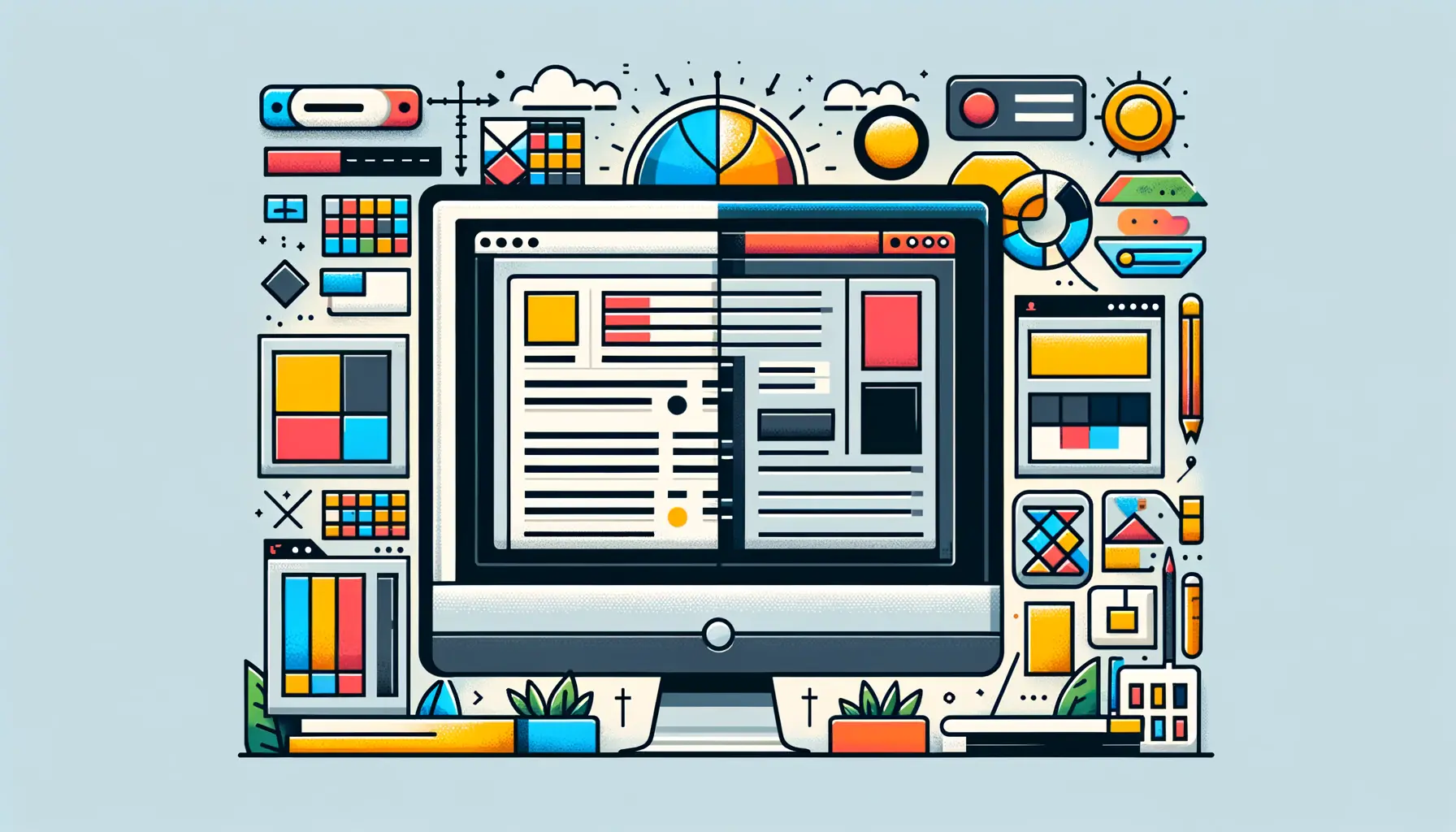The evolution of web design and development has always been about pushing the boundaries of what’s possible, and nowhere is this more evident than in the realm of typography.
The future of web fonts in CSS is a topic that excites designers, developers, and content creators alike, as it promises to bring a new level of creativity and functionality to the web.
As we delve into this future, we’re looking at a landscape where the choice and customization of fonts are becoming more accessible and varied, thanks to advancements in CSS and web technologies.
Typography plays a crucial role in the user experience, offering not just a means of conveying information, but also setting the tone, mood, and personality of a website.
With the main keyword “web” at the heart of our discussion, we explore how CSS, the styling language of the web, is evolving to support a richer, more dynamic range of web fonts.
This progression is not just about aesthetics; it’s about performance, accessibility, and the seamless integration of type into our digital lives.
- Introduction to Web Fonts and CSS
- Advancements in Font Loading and Rendering
- Variable Fonts: Revolutionizing Typography
- Typography and User Experience
- Responsive Typography Techniques
- Optimizing Performance with Web Fonts
- CSS Techniques for Advanced Typography
- Embracing the Future of Web Fonts in CSS
- FAQs: The Future of Web Fonts in CSS
Introduction to Web Fonts and CSS
Understanding Web Fonts
Web fonts have revolutionized the way we think about typography on the web.
Unlike traditional fonts that had to be installed on a user’s device, web fonts are hosted online and can be accessed by any web page through CSS.
This has opened up a world of possibilities for designers, allowing for more creative and consistent typography across different platforms and devices.
The integration of web fonts into CSS has been a game-changer, enabling designers to use a wide array of typefaces beyond the limited selection of ‘web-safe’ fonts.
This flexibility has significantly impacted design trends and user experiences, making websites more engaging and expressive.
The Role of CSS in Typography
CSS, or Cascading Style Sheets, is the language used to describe the presentation of HTML documents, including aspects like layout, colors, and fonts.
When it comes to typography, CSS provides the tools to implement web fonts, control their appearance, and ensure they adapt to various screen sizes and resolutions.
This capability is crucial for responsive design, ensuring that text is readable and appealing on any device.
Recent advancements in CSS, such as the @font-face rule, have made it easier to include web fonts in websites.
This rule allows designers to specify online fonts to use in their designs, giving them unprecedented control over typography.
As CSS continues to evolve, we can expect even more sophisticated typographic capabilities, making the web a more visually diverse and accessible space.
The integration of web fonts into CSS has not only enhanced the visual appeal of the web but also its accessibility and performance, marking a significant advancement in web design and development.
Advancements in Font Loading and Rendering
The way web fonts are loaded and rendered on websites has a significant impact on both performance and user experience.
Historically, the loading of web fonts could cause delays in text rendering, leading to the infamous “flash of unstyled text” (FOUT) or even the “flash of invisible text” (FOIT).
However, recent advancements in CSS and font technologies have introduced new methods to improve this process, enhancing the overall efficiency and visual stability of web pages.
One of the key developments in this area is the introduction of the `font-display` CSS property.
This feature offers web designers and developers more control over font loading behavior, allowing them to decide how fonts are displayed during the loading process.
The options range from immediately using a fallback font and then swapping to the web font once it’s loaded, to simply hiding the text until the web font is available.
This flexibility helps in minimizing the impact of web font loading on the user experience.
Font Loading Strategies
- Preloading: Using the `preload` link relation in HTML, specific fonts can be loaded earlier in the page load process. This is particularly useful for fonts that are critical to the initial rendering of the page.
- Font Display Swap: This strategy, facilitated by the `font-display: swap;` property in CSS, allows text to be shown with a fallback font and then swapped with the intended font once it loads, reducing perceived loading times.
- Asynchronous Loading: JavaScript-based solutions can load fonts asynchronously, reducing the impact on page load times. Libraries and APIs are available to manage this process more efficiently.
Improvements in Font Rendering
Font rendering, or the way text is displayed on the screen, has also seen improvements.
Subpixel rendering and anti-aliasing techniques have made text clearer and easier to read on various devices.
Additionally, variable fonts, a relatively new technology, offer a single font file that behaves like multiple fonts, providing a wide range of stylistic variations without the need to load multiple font files.
This not only improves rendering but also significantly reduces the amount of data needed, speeding up web performance.
With these advancements, the future of web fonts in CSS looks promising.
The focus on performance and user experience is leading to faster, more responsive, and visually appealing websites.
As these technologies continue to evolve, we can expect even more innovative approaches to font loading and rendering, further enhancing the web as a platform for creative expression and information dissemination.
Optimizing font loading and rendering is crucial for improving website speed and user experience, making it a key consideration for web developers and designers.
Variable Fonts: Revolutionizing Typography
Variable fonts represent one of the most significant advancements in typography in recent years, offering a versatile solution that is transforming web design.
These fonts consolidate multiple variations of a typeface into a single file, allowing designers to adjust style, weight, width, and other attributes on the fly.
This innovation not only simplifies font management but also opens up new creative possibilities for dynamic, responsive design.
The introduction of variable fonts is a response to the increasing complexity of web design and the need for more flexible, performance-oriented solutions.
By reducing the number of font files required for a website, variable fonts significantly decrease load times and improve performance.
Moreover, they enable a level of typographic finesse and adaptability that was previously difficult to achieve in web environments.
Benefits of Variable Fonts
- Performance: A single variable font file can replace multiple individual font files, reducing HTTP requests and speeding up website loading times.
- Flexibility: Designers can fine-tune the appearance of text for different screen sizes, resolutions, and languages, enhancing readability and user experience.
- Creativity: The ability to adjust font characteristics dynamically allows for creative typographic treatments and animations that respond to user interactions or environmental conditions.
Implementing Variable Fonts in CSS
Implementing variable fonts in CSS is straightforward, thanks to the `@font-face` rule and CSS custom properties.
Designers can specify the variable font and use CSS to dynamically adjust its properties, such as weight or width, based on user interaction or viewport size.
This approach not only enhances the visual appeal of a website but also its interactivity and responsiveness.
As variable fonts become more widely adopted, we can expect them to play a pivotal role in the future of web typography.
Their ability to combine performance, flexibility, and creativity makes them an invaluable tool for designers seeking to push the boundaries of web design.
With ongoing improvements and increasing support across browsers, variable fonts are set to redefine our expectations for web typography.
Variable fonts are a game-changer for web design, offering unprecedented flexibility and performance benefits that can significantly enhance the user experience.
Typography and User Experience
The influence of typography on user experience (UX) cannot be overstated.
The choice of fonts, their size, spacing, and color, all play critical roles in how content is perceived and interacted with on the web.
Good typography enhances readability, accessibility, and the overall aesthetic of a site, contributing to a positive user experience.
Conversely, poor typography can detract from the user’s engagement, making content difficult to read and navigate.
As web technologies have evolved, so have the opportunities to tailor typography to improve UX.
CSS offers a suite of properties that can be fine-tuned to optimize text for readability and visual appeal across devices.
This includes control over font size, line height, letter spacing, and text alignment, among others.
The advent of web fonts and variable fonts has further expanded the toolkit available to designers, enabling more expressive and adaptable typographic designs.
Key Typography Practices for Enhancing UX
- Consistency: Maintaining a consistent typographic hierarchy across a website helps users navigate and understand the structure of content.
- Contrast: Ensuring high contrast between text and its background improves readability, especially for users with visual impairments.
- Responsiveness: Typography should be responsive, adapting to different screen sizes and orientations to maintain readability and accessibility on any device.
Typography’s Impact on Accessibility
Accessibility is a crucial aspect of UX, and typography plays a significant role in making web content accessible to all users, including those with disabilities.
A well-designed typographic system considers the needs of users with visual impairments, dyslexia, and other conditions that affect reading.
This includes the use of legible font choices, adequate font sizes, and sufficient spacing.
Additionally, semantic HTML and CSS can be used to create a logical structure that screen readers can interpret correctly, further enhancing accessibility.
The future of web fonts in CSS is closely tied to the ongoing pursuit of better user experiences.
As designers and developers gain access to more advanced tools and techniques for manipulating typography, the potential to create more engaging, accessible, and effective web content grows.
Typography, at its core, is about communication, and by prioritizing UX in typographic design, we ensure that our messages reach and resonate with our audiences more effectively.
Effective typography is essential for creating positive user experiences, making it a fundamental aspect of web design and development.
Responsive Typography Techniques
As the web has evolved into a dynamic, multi-device platform, the importance of responsive design has become paramount.
Typography, being a cornerstone of web design, must adapt to this fluid environment to ensure content is legible and accessible across all devices.
Responsive typography involves adjusting type settings based on screen size, resolution, and other factors to maintain readability and user experience.
CSS provides a robust framework for implementing responsive typography, leveraging units and functions that allow text to scale dynamically.
Implementing responsive typography is not just about adjusting font sizes; it’s about considering all typographic elements, including line height, letter spacing, and word spacing, to enhance text readability and user engagement.
By employing responsive typography techniques, designers can create a seamless reading experience that adapts to the user’s environment, improving the overall usability of web content.
Units for Responsive Typography
- Viewport Width (vw): A unit that allows font size to scale based on the width of the viewport, making it ideal for fluid text resizing.
- Viewport Height (vh): Similar to vw, but based on the height of the viewport. This unit can be useful for creating dynamic text that adapts to screen height.
- Rem and Em: These units are relative to the root font size (rem) or the font size of the parent element (em), providing scalability within a hierarchical structure.
Media Queries and Typography
Media queries are a powerful tool in CSS for implementing responsive design, including typography.
By defining different typographic styles for various screen sizes and conditions, designers can ensure that text remains legible and aesthetically pleasing across devices.
This might involve changing font sizes, line heights, and even font weights to better suit the display characteristics of smartphones, tablets, and desktops.
Responsive typography is a critical aspect of modern web design, ensuring that content is accessible and readable no matter how or where it is viewed.
As web technologies continue to advance, the tools and techniques available for creating responsive typography will expand, offering even greater control and creativity to designers.
The future of web fonts in CSS is intrinsically linked to the evolution of responsive design, promising a more adaptable and user-friendly web.
Responsive typography is essential for creating accessible, legible, and engaging content across all devices, making it a key consideration in modern web design.
Optimizing Performance with Web Fonts
The integration of web fonts into a website’s design can significantly enhance its aesthetic appeal and brand identity.
However, without careful consideration, web fonts can also impact a site’s performance, potentially slowing down page load times and affecting user experience.
Optimizing web font performance is therefore crucial, involving strategies to ensure fonts load efficiently while maintaining the visual integrity of the site.
Performance optimization for web fonts involves a combination of selecting the right fonts, implementing efficient font loading techniques, and minimizing the overall impact on page load times.
By addressing these aspects, developers can leverage the benefits of web fonts without compromising on speed and user experience.
Font Selection and Optimization
- Choosing Efficient Fonts: Some fonts are inherently more complex and larger in file size. Opting for simpler, more efficient fonts can reduce load times.
- Subsetting Fonts: This involves including only the specific characters and glyphs used on the site in the font file, reducing its size.
- Using WOFF2 Format: The Web Open Font Format 2 (WOFF2) offers superior compression, making it a preferred choice for web fonts.
Efficient Font Loading Techniques
Implementing smart font loading techniques can mitigate the performance impact of web fonts.
Techniques such as using the `font-display` CSS property, preloading critical fonts, and loading non-critical fonts asynchronously ensure that text remains visible and usable, even if fonts are still loading.
Additionally, leveraging browser cache by hosting fonts locally or using a reliable content delivery network (CDN) can further enhance performance.
Optimizing web font performance is an ongoing process that plays a critical role in web design and development.
As the web continues to evolve, so too will the strategies and technologies available to optimize fonts.
By prioritizing performance alongside aesthetics, developers can create sites that are not only beautiful but also fast and user-friendly.
Neglecting web font performance can lead to slower page load times and a poor user experience, underscoring the importance of optimization in web design.
CSS Techniques for Advanced Typography
As the web evolves, so do the possibilities for typography.
CSS offers a plethora of advanced techniques that enable designers to implement complex typographic designs with ease and precision.
These techniques not only enhance the visual appeal of websites but also improve readability and user engagement.
From text effects to layout control, CSS provides the tools necessary to bring sophisticated typography to life on the web.
Exploring these advanced techniques reveals the depth of creativity and functionality that can be achieved through CSS.
By leveraging these capabilities, designers can create unique, expressive, and dynamic typographic experiences that stand out in the digital landscape.
Text Effects and Layout
- Text Shadow: CSS `text-shadow` property allows for the creation of text effects such as shadows, giving depth and emphasis to web typography.
- Clipping and Masking: Text can be clipped or masked to create interesting visual effects, using shapes or images to define the visible area of the text.
- Grid and Flexbox for Typographic Layout: CSS Grid and Flexbox modules offer powerful layout systems that can be used to design complex typographic arrangements, enhancing the structure and hierarchy of web content.
Responsive and Interactive Typography
Advanced CSS techniques also extend to creating responsive and interactive typographic designs.
Utilizing viewport units, media queries, and CSS animations, typography can be made to respond to screen size changes and user interactions.
This dynamic approach to typography not only improves the user experience but also adds a layer of engagement and interactivity to web content.
The future of web fonts in CSS is marked by these advanced techniques, which continue to push the boundaries of what’s possible in web typography.
As CSS evolves, we can anticipate even more innovative tools and methods for creating compelling, effective, and accessible typographic designs.
The potential for creativity and expression in web typography is limitless, offering exciting opportunities for designers to explore and innovate.
Leveraging advanced CSS techniques for typography allows designers to create more engaging, expressive, and accessible web content, highlighting the importance of typography in web design.
Embracing the Future of Web Fonts in CSS
The journey through the evolving landscape of web fonts in CSS underscores a pivotal shift in web design and development.
As we’ve explored, the integration of web fonts has transcended mere aesthetics, touching upon performance, accessibility, and the very way we interact with text on the web.
The future of web fonts in CSS is not just about the fonts themselves but how they are implemented, optimized, and experienced by users across the globe.
The Path Forward
Looking ahead, the trajectory of web fonts in CSS is marked by several key trends and innovations.
Variable fonts, responsive typography, and advanced CSS techniques represent just the beginning of what’s possible.
As technology advances, so too will the tools and methods at our disposal, enabling even more dynamic, efficient, and creative typographic experiences.
Key Takeaways
- Performance optimization and efficient font loading strategies will continue to be crucial, ensuring that the use of web fonts does not compromise the speed and accessibility of websites.
- Variable fonts are set to play a central role, offering unparalleled flexibility and efficiency that can significantly enhance both design and performance.
- Responsive typography techniques will evolve, ensuring that text remains legible and engaging across all devices and screen sizes.
- Advanced CSS techniques will unlock new possibilities for typographic creativity and expression, pushing the boundaries of what can be achieved with text on the web.
In conclusion, the future of web fonts in CSS is bright, filled with potential for innovation and improvement.
As designers and developers, embracing these advancements and exploring new possibilities will be key to creating more beautiful, functional, and accessible websites.
The main keyword, “web,” is at the heart of this evolution, reminding us that as the digital landscape changes, so too must our approaches to design and development.
By staying informed and adaptable, we can look forward to a future where web fonts continue to enrich our online experiences in ever more impactful ways.
Quality web design is key for a great website! Check out our service page to partner with an expert web design agency.
FAQs: The Future of Web Fonts in CSS
Explore common questions about the evolving world of web fonts and CSS, providing insights into future trends and best practices.
The CSS font-display property controls how web fonts are displayed during loading, enhancing user experience by reducing invisible text.
Web fonts can affect site speed and performance, but optimization techniques like font subsetting and using WOFF2 format mitigate these issues.
Variable fonts are a single font file that acts as multiple fonts, offering a range of styles and weights to enhance design flexibility.
Web fonts enhance brand identity and user experience by allowing for creative, consistent typography across different platforms and devices.
Optimizing web fonts involves selecting efficient fonts, subsetting, and implementing loading strategies to improve website loading times.
Web fonts are crucial for responsive design, allowing typography to adapt seamlessly across devices for consistent readability and user experience.
Advancements in CSS, like variable fonts and new layout techniques, offer greater control and creativity in web typography.
Future trends include more efficient font loading, increased use of variable fonts, and enhanced typography responsiveness and accessibility.













